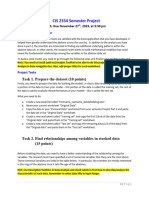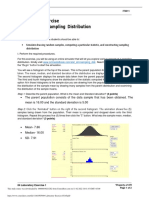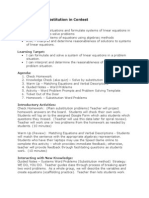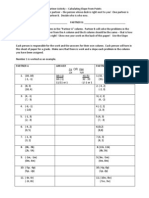0 ratings0% found this document useful (0 votes)
2K viewsStation 3
Station 3
Uploaded by
Beth FergusonThe document discusses exploring the relationship between the number of points and segments by creating a scatterplot on a calculator using data from a table. It instructs to identify the best fitting parent function, find a regression equation, and use that equation to estimate the number of points given segments or vice versa.
Copyright:
© All Rights Reserved
Available Formats
Download as PDF, TXT or read online from Scribd
Station 3
Station 3
Uploaded by
Beth Ferguson0 ratings0% found this document useful (0 votes)
2K views1 pageThe document discusses exploring the relationship between the number of points and segments by creating a scatterplot on a calculator using data from a table. It instructs to identify the best fitting parent function, find a regression equation, and use that equation to estimate the number of points given segments or vice versa.
Original Description:
Finding the line of best fit
Copyright
© © All Rights Reserved
Available Formats
PDF, TXT or read online from Scribd
Share this document
Did you find this document useful?
Is this content inappropriate?
The document discusses exploring the relationship between the number of points and segments by creating a scatterplot on a calculator using data from a table. It instructs to identify the best fitting parent function, find a regression equation, and use that equation to estimate the number of points given segments or vice versa.
Copyright:
© All Rights Reserved
Available Formats
Download as PDF, TXT or read online from Scribd
Download as pdf or txt
0 ratings0% found this document useful (0 votes)
2K views1 pageStation 3
Station 3
Uploaded by
Beth FergusonThe document discusses exploring the relationship between the number of points and segments by creating a scatterplot on a calculator using data from a table. It instructs to identify the best fitting parent function, find a regression equation, and use that equation to estimate the number of points given segments or vice versa.
Copyright:
© All Rights Reserved
Available Formats
Download as PDF, TXT or read online from Scribd
Download as pdf or txt
You are on page 1of 1
Station 3
Holt Algebra 2 Chapter 1
The number of segments required to connect
a given number of points is shown in the table above.
Use your calculator to explore the
relationships between points and segments.
1. Create a scatterplot of the relationship on your calculator.
2. Identify the parent function that best describes the data
3. Find a regression equation.
4. Is this problem situation continuous or discrete?
5. Use your equation to estimate the number of points if
there are 45 segments.
6. Use your equation to estimate the number of segments if
there are 7 points.
You might also like
- 3-Slope Intecept Form NotesDocument1 page3-Slope Intecept Form NotesBeth Ferguson50% (4)
- Module 2 - Spot It! - COMP 140 F23Document5 pagesModule 2 - Spot It! - COMP 140 F23Iftekhar Ahmed TonoyNo ratings yet
- Unit 14 TST TestDocument7 pagesUnit 14 TST TestJeannette MoriakNo ratings yet
- Quiz 1Document8 pagesQuiz 1doan nguyenNo ratings yet
- General Mathematics: Quarter 1 Week 2 Module 5Document11 pagesGeneral Mathematics: Quarter 1 Week 2 Module 5Barez Fernandez ZacNo ratings yet
- Math3 Q3 Aralin 60 Comparing Dissimilar FractionsDocument83 pagesMath3 Q3 Aralin 60 Comparing Dissimilar FractionsSheila Roxas82% (11)
- 8th Grade Math Textbook CMSDocument338 pages8th Grade Math Textbook CMSAejaz Mohamed100% (3)
- Partner Activity - Graphing SystemsDocument2 pagesPartner Activity - Graphing SystemsBeth FergusonNo ratings yet
- Summary Web For Point Slope FormDocument1 pageSummary Web For Point Slope FormBeth Ferguson100% (1)
- Slope Intercept GameboardDocument42 pagesSlope Intercept GameboardBeth Ferguson100% (3)
- What You Have Learned About Handling DataDocument1 pageWhat You Have Learned About Handling DataAliyah LuharNo ratings yet
- Frequency Tables & Bar Charts WorksheetDocument8 pagesFrequency Tables & Bar Charts Worksheetaylen.rodriguezNo ratings yet
- Common Core State Standards: National Glencoe Math, Course 2, © 2015Document13 pagesCommon Core State Standards: National Glencoe Math, Course 2, © 2015ahmed5030 ahmed5030No ratings yet
- Attachment 1Document4 pagesAttachment 1sammiepetez8No ratings yet
- Pa TextbookDocument338 pagesPa TextbooksunethraNo ratings yet
- Problem Analysis Tools: Fishbone Diagram, Matrix Diagram and Scatter Plot DiagramDocument30 pagesProblem Analysis Tools: Fishbone Diagram, Matrix Diagram and Scatter Plot DiagramLance_Joshua_7907No ratings yet
- Proportions - Lab (6-2 Part 1) PDFDocument7 pagesProportions - Lab (6-2 Part 1) PDFAnonymous 3Cw3fUNo ratings yet
- CHSD230 Math 1 Module 4 SEDocument80 pagesCHSD230 Math 1 Module 4 SETravis EubanksNo ratings yet
- Assignment 4Document5 pagesAssignment 4Usman ShahidNo ratings yet
- HW 2 Online Dfadfa Fadmsklfm Mlfmad Mlkfadmf FadDocument4 pagesHW 2 Online Dfadfa Fadmsklfm Mlfmad Mlkfadmf Fadkukhunga2No ratings yet
- G7 Y8 20-21 T3 W3 L1 Theory FlowchartsDocument14 pagesG7 Y8 20-21 T3 W3 L1 Theory FlowchartsDr-Afaq Hyder ChohanNo ratings yet
- 2015-16 Aps Fifth Grade Advanced Curriculum MapDocument8 pages2015-16 Aps Fifth Grade Advanced Curriculum Mapapi-291816007No ratings yet
- Lesson 7 Analytics With ExcelDocument55 pagesLesson 7 Analytics With ExcelplabitNo ratings yet
- MAP4C Exponential Task Name: - Partner: - DateDocument2 pagesMAP4C Exponential Task Name: - Partner: - DateCharbel TaouilNo ratings yet
- Exponents RuleDocument11 pagesExponents RulepamelaNo ratings yet
- 6th Grade Math Curriculum MapDocument6 pages6th Grade Math Curriculum Mapapi-109360342No ratings yet
- Algebra 1 Unit 6 Describing Data NotesDocument13 pagesAlgebra 1 Unit 6 Describing Data Notesapi-287816312No ratings yet
- Kami Export - Maximus Zhu - Unit 3 Lesson 2 CW .docxDocument7 pagesKami Export - Maximus Zhu - Unit 3 Lesson 2 CW .docxmdzhuNo ratings yet
- Types of QuestionsDocument8 pagesTypes of Questionsaaravagarwal.1511No ratings yet
- Lab 3 DescriptionDocument3 pagesLab 3 DescriptionУляна ДоценкоNo ratings yet
- Open 3.1 Rat.-3.1 Rational Equations-01Document20 pagesOpen 3.1 Rat.-3.1 Rational Equations-01niña CosmianoNo ratings yet
- Math WorksheetDocument9 pagesMath Worksheete_petrakiNo ratings yet
- 337 Final ProjectDocument10 pages337 Final Projectapi-209574864No ratings yet
- MATH-6 Q2 Mod14Document12 pagesMATH-6 Q2 Mod14KC GaytanoNo ratings yet
- A Level Further Mathematics For AQA - Discrete Student Book (AS - A Level)Document268 pagesA Level Further Mathematics For AQA - Discrete Student Book (AS - A Level)NghiaNo ratings yet
- October 17: Great Learning Authored By: ANIMESH HALDERDocument19 pagesOctober 17: Great Learning Authored By: ANIMESH HALDERanimehNo ratings yet
- 11 4 - 6 14 Proportional-Reasoning - ProjectDocument7 pages11 4 - 6 14 Proportional-Reasoning - Projectapi-269188118No ratings yet
- M20-2 - Unit - 3 - Assignment 2022Document9 pagesM20-2 - Unit - 3 - Assignment 2022AmanNo ratings yet
- Math 3Document25 pagesMath 3princelouie.santosNo ratings yet
- Feedback 3Document2 pagesFeedback 3api-307595838No ratings yet
- Reading - 24 - 11Document18 pagesReading - 24 - 11kaitoraisenNo ratings yet
- Spring 2023 Signature Assignment ADA MAT 152 With Rubric Excel Bonanno 2Document4 pagesSpring 2023 Signature Assignment ADA MAT 152 With Rubric Excel Bonanno 2cordovacarameloNo ratings yet
- Chapter 1 Lecture Notes-1Document17 pagesChapter 1 Lecture Notes-1mtohf7No ratings yet
- Mei c3 Coursework Comparison MethodsDocument8 pagesMei c3 Coursework Comparison Methodsfrebulnfg100% (2)
- 04 Laboratory Exercise STAT PDFDocument4 pages04 Laboratory Exercise STAT PDFAdrasteia Zachry100% (1)
- Math Report 1Document34 pagesMath Report 1balquinbesmonteNo ratings yet
- Math 5645 home work 1Document2 pagesMath 5645 home work 1fvrg8b9qg9No ratings yet
- Grade 6 Chapter 6 fraction addition and subtractionDocument36 pagesGrade 6 Chapter 6 fraction addition and subtractionreemaNo ratings yet
- CS 672 - Neural Networks - Practice - Midterm - SolutionsDocument7 pagesCS 672 - Neural Networks - Practice - Midterm - SolutionsMohammed AL-waaelyNo ratings yet
- MTC8 0602 Q2 FPFDocument28 pagesMTC8 0602 Q2 FPFJohn Philip ReyesNo ratings yet
- C.Homework 4 PDFDocument3 pagesC.Homework 4 PDFAndrei CojocaruNo ratings yet
- Amy Corns - Connecting Scatter Plots and Correlation Coefficients ActivityDocument23 pagesAmy Corns - Connecting Scatter Plots and Correlation Coefficients ActivityRonvan AspillaNo ratings yet
- Exploratory Factor Analysis and Principal Components AnalysisDocument16 pagesExploratory Factor Analysis and Principal Components AnalysisTehzeeb FaizanNo ratings yet
- 5_5_HW Answers Graphs_of_Proportional_RelationshipsDocument7 pages5_5_HW Answers Graphs_of_Proportional_RelationshipsakiokingstonNo ratings yet
- Algebra SummativeDocument13 pagesAlgebra Summativeapi-379755793No ratings yet
- ps5 BuildDocument1 pageps5 Buildsowmya suswaramNo ratings yet
- General Mathematics: Quarter 1 Week 2 Module 3Document9 pagesGeneral Mathematics: Quarter 1 Week 2 Module 3joebert agraviadorNo ratings yet
- Basic Mathematics Final ExamDocument12 pagesBasic Mathematics Final ExamScribdTranslationsNo ratings yet
- Survey Simulator - Student GuideDocument7 pagesSurvey Simulator - Student Guide3va1barraNo ratings yet
- PHY Lab IntroductionDocument30 pagesPHY Lab IntroductionkrittametsupmunNo ratings yet
- Course C Programming Language Topic: RecursionDocument2 pagesCourse C Programming Language Topic: RecursionAndrei CojocaruNo ratings yet
- Me Math 7 q1 0303 SGDocument15 pagesMe Math 7 q1 0303 SGJohn Michael SibayanNo ratings yet
- Grade 3 Math FractionsDocument11 pagesGrade 3 Math Fractionsfocuc98No ratings yet
- Tyler Broussard - 8.8 Explore I Balanced and Unbalanced ForcesDocument3 pagesTyler Broussard - 8.8 Explore I Balanced and Unbalanced ForcesbroutylNo ratings yet
- Station 1Document4 pagesStation 1Beth Ferguson100% (1)
- Station 5 Domain & Range: Graph 1 Graph 2Document1 pageStation 5 Domain & Range: Graph 1 Graph 2Beth Ferguson100% (1)
- Cotton Vs CornDocument2 pagesCotton Vs CornBeth FergusonNo ratings yet
- Day 3 Solving Systems Using EliminationDocument2 pagesDay 3 Solving Systems Using EliminationBeth FergusonNo ratings yet
- Day 2 Solving Systems of Equations Using SubstitutionDocument2 pagesDay 2 Solving Systems of Equations Using SubstitutionBeth FergusonNo ratings yet
- Day 1 Solving Systems of Equations by GraphingDocument2 pagesDay 1 Solving Systems of Equations by GraphingBeth FergusonNo ratings yet
- Analyzing Data: Discuss These Questions With Your Math TeamDocument2 pagesAnalyzing Data: Discuss These Questions With Your Math TeamBeth FergusonNo ratings yet
- Station 4Document1 pageStation 4Beth FergusonNo ratings yet
- Station 2Document1 pageStation 2Beth FergusonNo ratings yet
- Rational Exponents Booklet Pages 4 and 5Document1 pageRational Exponents Booklet Pages 4 and 5Beth FergusonNo ratings yet
- Observation Lesson PlanDocument2 pagesObservation Lesson PlanBeth FergusonNo ratings yet
- Rational Exponents Booklet Pages 3 and 6Document1 pageRational Exponents Booklet Pages 3 and 6Beth FergusonNo ratings yet
- Purple Invaders MissionDocument1 pagePurple Invaders MissionBeth FergusonNo ratings yet
- Poetry Rubric For Math ClassDocument1 pagePoetry Rubric For Math ClassBeth FergusonNo ratings yet
- Monomial War ProblemsDocument1 pageMonomial War ProblemsBeth FergusonNo ratings yet
- Review Graphing Linear Equations NotesDocument1 pageReview Graphing Linear Equations NotesBeth Ferguson0% (1)
- 1 Introductory ExplorationDocument1 page1 Introductory ExplorationBeth Ferguson100% (3)
- Point-Slope Class NotesDocument1 pagePoint-Slope Class NotesBeth Ferguson100% (3)
- 2-Guided Discussion #1 & #2Document1 page2-Guided Discussion #1 & #2Beth FergusonNo ratings yet
- 4b-LINES Answer SheetDocument1 page4b-LINES Answer SheetBeth FergusonNo ratings yet
- 4a LINES ActivityDocument1 page4a LINES ActivityBeth Ferguson100% (1)
- Partner Slope ActivityDocument1 pagePartner Slope ActivityBeth Ferguson100% (1)





















































































